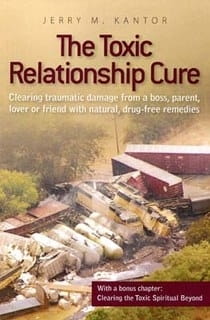Clearing traumatic damage from a boss, parent, lover or friend with natural, drug-free remedies
Using engaging client stories, The Toxic Relationship Cure reveals how little-known natural medicines can relieve mental, emotional and physical damage from toxic and unhealthy relationships.
The Toxic Relationship Cure is meant for victims of these toxic relationships as well as mental health professionals. Often frustrated by these clients’ stubbornly self-destructive behaviours, mental health clinicians will find new hope in these pages.
The toxic relationships include Boss, Parent, Lover, Friend, and the Spiritual Beyond (dysfunctional relationship with God, spirit or a deceased individual). Vivid stories based on actual cured cases render memorable portraits of each natural medicine type. The description of each medicine even includes physical symptoms it is likely to cure.
These natural medicines are widely used in Europe and have many advantages over conventional psychopharmacology medications:
- They are non-addictive and non-toxic.
- They have side benefits instead of side effects: clients report improvement in apparently-unrelated physical ailments as well as in overall energy and quality of sleep.
- Their use is supported by research including a study by the Swiss government concluding that these medicines are as effective as conventional medicines yet less expensive.
- The average cost is less than a penny per day.
- Instead of “you’ll be on this drug for the rest of your life,” their effect tends to be curative within months.
The Toxic Relationship Cure is engaging to read and empowering to implement, with guidance for both clients and professionals.
- Author: Jerry M Kantor
- ISBN: 9780984678815
- 155 pages
- Paperback
- Published in 2013
- Printed in United States
Reviewed by Jennifer White, ND, DHANP, CCH
This book is an enjoyable read. Expect to be amused while learning materia medica. But, don’t let the title of the book fool you. You won’t be reading a book on PTSD (like I thought) but will instead find yourself reading entertaining stories grouped into traumas dispensed by a boss, parent, lover, friend, and spiritual beyond.
It’s written in a narrative style with short descriptions of part-factual and part-fictional patient vignettes. Each description comes with Mr Kantor’s analysis of what a possible curative response for each patient would look like, which is often a modification of the patient’s symptoms into less severe forms of illness where he then suggests a less pathological remedy. He ends each patient section with a short description of complementary remedies. There are 32 remedy scenarios in the book, which range from polycrests - such as Nat-m and Lycopodium - to the rarely constitutional remedies of Absinthum, Bismuth, and Gratiola.
This book would be an excellent adjunct for a student, and the quickly read scenarios would make for an excellent book in the waiting room. Mr Kantor’s goal of appealing to the experienced homeopath and the non-homeopathically educated is challenging due to the large gap in knowledge between the two; this thread is stretched thin while attempting to provide sufficient knowledge while at the same time simply introducing an idea. For the non-homeopathically educated, it would function well as an introduction to the type of treatment that homeopathy offers. And, for the experienced homeopath you will find the book to be enjoyably entertaining, and you will find it to be injected with occasional a-ha moments and treats of the few rare constitutional remedy pictures.
However, as an experienced homeopath myself, I genuinely look forward to Mr Kantor writing a 2nd Edition that expounds on his ideas offered in this book. If it were to combine these ideas with materia medica, I think we’d find another jewel of a resource book for homeopaths, similar to what the Desktop Guide by Roger Morrison has been for many. The unique twist that Mr Kantor provides is very appealing—this being his Chinese Medicine perspectives on the organ relationship to conditions and his views on the somatization of emotional, mental, and spiritual disharmonies. He also discusses an intriguing perspective on the cause of disease in Appendix One and terms it Radical Disjunct. He states that “when the denial of a need in question is sufficiently extreme, an apparent paradox results: when provided later, satisfaction of the need not only fails to satisfy, it worsens the individual’s general state.” Expounding on these ideas would be valuable to the homeopathic profession.
In the end, The Toxic Relationship Cure is nicely entertaining and could easily serve to educate those new to homeopathy and the non-homeopath. For the experienced homeopath you will find seeds of thought and insight into health from an organ perspective and perspective on somatization.
Dr Jennifer White, ND, DHANP, CCH is a homeopath located in Seattle, Washington. The majority of her practice is working with clients at the constitutional (and fundamental) homeopathic level; she also works in an Eizayaga-like and Vannier-like manner. She can be found at: www.seattlehomeopathy.com

